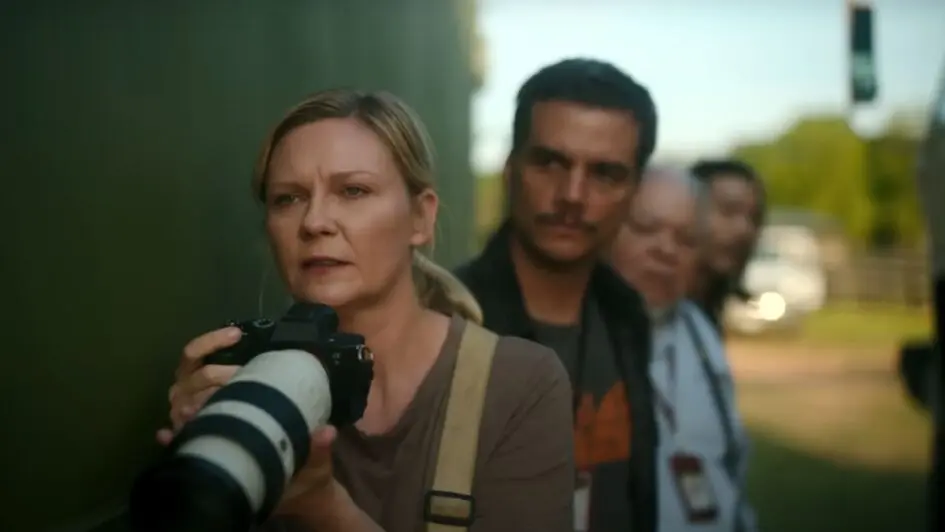After watching the new Alex Garland film, Civil War, I had many thoughts. Foremost, I wondered if it was entirely possible to like a movie while simultaneously feeling unnerved by its content, to the point of never wanting to see it again.
Such a dichotomy often arises when a film masterfully delves into unsettling themes or portrays intense emotional experiences with raw authenticity.
While one may admire the movie’s craftsmanship, powerful storytelling or thought-provoking messages, the discomfort and unease it evokes can linger long after the credits roll. This unease may stem from the film’s ability to tap into primal fears, provoke existential questions or expose the darker aspects of human nature. In essence, the love for the movie is tempered by the desire to shield oneself from its unnerving effects, making it a one-time experience that leaves a lasting impression.
In this dystopian version of America, the country is divided into four factions following the rise of a dictatorship under the current president (Nick Offerman): The Western Forces, consisting of California and Texas; The Florida Alliance, encompassing all states south and east of Arkansas and Tennessee; The New People’s Army, occupying the northern and northwest regions of the country; and the Loyalist States, comprising everything else.
Tensions escalate until a full-scale war breaks out, with The Western Forces launching an assault on the Loyalist States. Amidst this turmoil, four journalists — Lee (Kirsten Dunst), Joel (Wagner Moura), Jessie (Cailee Spaeny) and Sammy (Stephen McKinley Henderson) — embark on a perilous mission to interview the President, facing numerous challenges along the way.
Alex Garland deserves commendation for his astute presentation choices in Civil War. In today’s socio-political landscape, where movies often face categorization as either too liberal or too conservative, Garland’s decision to depict the conflict through the perspective of a team of journalists is a nuanced one, delicately balancing the complex issues at hand. By allowing the journalists to convey the narrative through their photographs, Garland leaves interpretation in the hands of the viewer, encouraging them to form their own conclusions.
The film portrays the horrors of war from both sides of the battle, showcasing acts of heroism and barbarism alike. As a result, Civil War deftly navigates the political spectrum, existing in the center without leaning excessively to the right or left. It avoids being preachy or one-sided, offering a thought-provoking exploration of the human experience amidst conflict.
The sheer intensity of Civil War is what prompted the initial question to surface in my mind. This film delivers unrelenting blows, leaving the audience reeling. Moments of tranquility, where characters share intimate conversations over drinks, are abruptly shattered by the cacophony of gunfire or the deafening roar of explosions. One moment, the journalists traverse through a seemingly peaceful town oblivious to the war, only to be met with sniper fire moments later. In another harrowing scene, a serene field transforms into a haunting landscape of a mass grave, revealing the brutal aftermath of violence.
The stark juxtaposition between these contrasting moments is profoundly jarring and unsettling. While a certain level of tension is expected in a war movie, Civil War takes it to an unprecedented level, evoking a sense of anxiety that lingers long after the credits roll. And it is that unnerving feeling that may keep others, like me, from seeing this movie multiple times.
Upon reflection, I couldn’t shake the comparison with the 1968 classic, Night of the Living Dead. While the two films differ vastly in their plots — Civil War lacks the presence of Zombies or supernatural elements — the underlying narratives offer a parallel exploration of their respective era’s anxieties and fears. Both films grapple with the breakdown of societal norms and institutions, echoing the disillusionment of their times. Night of the Living Dead’s bleak and nihilistic tone reflects the despair of the Vietnam War era, while Civil War channels similar sentiments through its examination of contemporary political issues.
Ultimately, both movies stand as powerful commentaries on the societal tensions and upheavals of their time frames, resonating with audiences for their insightful portrayals of human nature and societal crises.
The film’s most significant flaw becomes glaringly apparent in its final 20 minutes. Without divulging spoilers, one of the characters undergoes a drastic shift in demeanor as the climax approaches. The issue lies in the lack of foreshadowing or buildup to this transformation. It feels as though a pivotal plot point may have been inadvertently omitted during the editing process. This alteration isn’t subtle; rather, it’s a sudden and jarring 180-degree turn that seems to emerge out of nowhere.
Instead of focusing on the film’s conclusion, I found myself preoccupied with deciphering the rationale behind this inexplicable change. Despite thorough analysis and consultation with fellow critics, no justification for this abrupt character shift could be discerned.
Civil War earns a low three out of five stars. Its final act suffers from a glaring omission of crucial information that could have provided insight into a certain character’s abrupt personality shift. This oversight detracts from the impact of the film’s explosive and action-packed conclusion. Still, director Garland achieves the commendable feat of navigating the film’s themes without succumbing to bias.
However, the unsettling portrayal of potential societal outcomes hits uncomfortably close to home, making it all too easy to envision such events unfolding in the near future. Civil War’s unflinching portrayal of these issues renders it a compelling watch, albeit one I have no desire to revisit.

